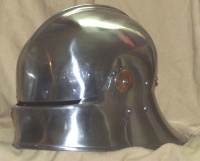Sallet: Difference between revisions
From Cunnan
Jump to navigationJump to search
mNo edit summary |
No edit summary |
||
| Line 1: | Line 1: | ||
[[image:sallet01.jpg|right|200px|thumb|A fifteenth century sallet.]] |
|||
A '''sallet''' (pronounced either ''sal ay'' ([[France|French]]) or ''sall et'' (contemporary [[England|English]] pronounciation)) is a plate [[helmet]] with a pointed tail and either an open face or a horizontal eye slot. |
|||
A '''sallet''' or '''salade''' is a plate [[helmet]] with a pointed tail and either an open face or a horizontal eye slot. Primary ronunciations either ''sal ay'' ([[France|French]]) or ''sall et'' (contemporary [[England|English]] pronounciation)). |
|||
The jawbone may be articulated to allow greater airflow, and sometimes the tail might be articulated. The helmet may have also been painted with [[religion|relgious]] [[slogan]]s being popular as well as [[livery]] style colours. |
The jawbone may be articulated to allow greater airflow, and sometimes the tail might be articulated. The helmet may have also been painted with [[religion|relgious]] [[slogan]]s being popular as well as [[livery]] style colours. |
||
Revision as of 15:00, 11 March 2006
A sallet or salade is a plate helmet with a pointed tail and either an open face or a horizontal eye slot. Primary ronunciations either sal ay (French) or sall et (contemporary English pronounciation)).
The jawbone may be articulated to allow greater airflow, and sometimes the tail might be articulated. The helmet may have also been painted with relgious slogans being popular as well as livery style colours.
This was a popular helmet type during the 15th century particularly in the latter part. It was worn by nobles and men at arms.
